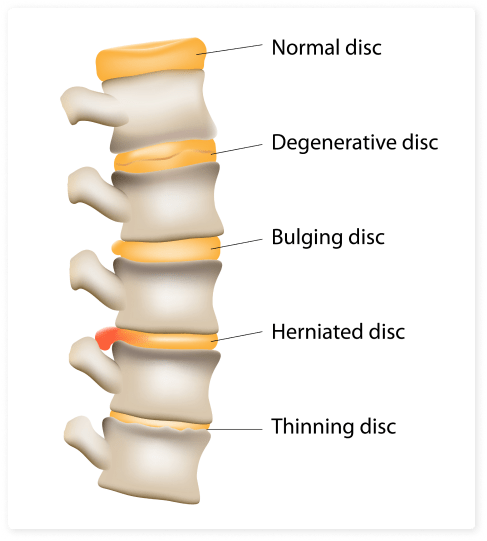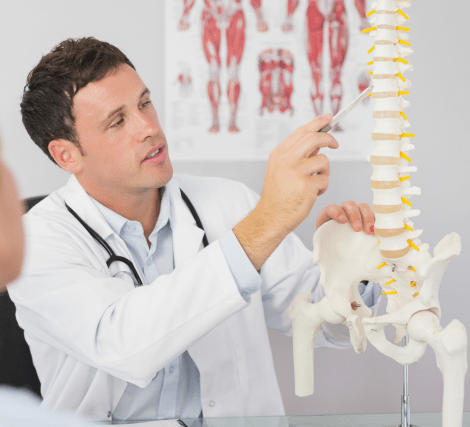Understanding
If back or neck pain is hampering your daily routine, you might be dealing with a ‘disc herniation’. This occurs when a spinal disc’s core pushes through a crack in its exterior, possibly compressing nearby nerves. This concise guide will outline the symptoms, explain treatment options, and offer practical recovery advice, giving you a clear path toward relief without the usual medical complexities.
Key Takeaways:
Understanding Disc Herniation: A Comprehensive Guide

Are you curious about what a ‘herniated disc’ is? It’s when the core, or inner nucleus, of an intervertebral disc, pushes out through a rupture in its exterior ring, known as the annulus fibrosus. This leads to discomfort and can pinch nearby nerves. Imagine squashing a jelly donut until its filling oozes out – that’s essentially what happens inside your spine! People often mix it up with another condition called ‘bulging disc’. There are distinct differences between them.
In contrast to a herniated disk, during the occurrence of bulging discs, only part of the internal segment extends beyond typical boundaries—it does not tear through—of their containing structure. Imagine how inflating pressure might cause one side of a cushion to extend beyond its usual limits without actually spilling any material from within.
Anatomy of a Herniated Disc
The cervical spine, with its complex structure, serves the vital purposes of supporting the head, allowing for flexibility and safeguarding the spinal cord. It shares similarities with the lumbar spine in terms of intervertebral discs’ functionality – these are doughnut-like cushions comprising a gelatinous nucleus pulposus inside surrounded by a tougher annulus fibrosus that collectively provide both shock absorption and structural integrity to our spines.
When considering conditions such as herniated disks—referred to interchangeably as herniated disc or disk—the crux lies in an anomaly where this central core breaks through its confining annular ring, reminiscent of jelly being forced out from within a donut. Differentiating between types of disc issues, including those affecting specific areas like a herniated lumbar disk, is essential in guiding accurate diagnosis and subsequent treatment strategies.

The Impact on Spinal Nerves
A herniated disc is far from being a passive, inconsequential condition. It can be quite disruptive within the spinal canal. When material from the disc protrudes, it has the potential to exert pressure on nearby spinal nerves, which in turn may manifest as pain, tingling sensations, or muscular weakness in regions correlated with the compromised nerve root. The severity of these symptoms can range widely. Some people might feel slight irritation, while others could suffer intensely debilitating discomfort.
Such issues stem not just from physical constriction but also due to elevated levels of inflammatory substances close to where the herniation occurred. If you can imagine swelling around a fresh ankle sprain and how all that pressure from the swelling causes severe pain. This same process happens in you spine and discs. If there is too much pressure and swelling in the area it can irritate those nerves and give you pain, tingling, numbness, etc.
Herniated Disc vs. Bulging Disc: Distinguishing the Conditions
Distinguishing a herniated disc from a bulging disc comes down to whether the containment is breached. A herniated disc, often referred to as disc extrusion, occurs when the core substance of the disk leaks out due to a rupture in its outer ring, known as the annulus fibrosus. On the other hand, with a bulging disc, there’s an outward swelling of the disk into the spinal canal without any actual tearing of that exterior ring. The difference can be likened to contrasting an overinflated water balloon that remains intact versus one that has been punctured and loses its inner contents.
Basically from a more simplistic view a disc bulge is a mild disc injury and a disc herniation is more moderate or possibly severe.

Causes and Risk Factors for Herniated Discs

Understanding the nature of a herniated disc, we shall delve into its origins. The primary culprit behind herniated discs is often degenerative disc disease. This condition leads to the drying out and subsequent fragility of the nucleus pulposus within the spine.
That’s not where it ends. Factors related to one’s lifestyle and job-related risks also significantly contribute to occurrences of disk herniation.
The Role of Age and Disk Degeneration
When it comes to the health of our spine, age is more than just a number. Our intervertebral discs deteriorate with time, leaving them prone to herniations. This weakening of disc structure occurs as part of the natural aging process and can increase the likelihood of suffering from a herniated disc because the discs become less flexible. Although this is an unwelcome aspect of aging, there are strategies to handle and reduce these risks.
The Role of Age and Disk Degeneration
When it comes to the health of our spine, age is more than just a number. Our intervertebral discs deteriorate with time, leaving them prone to herniations. This weakening of disc structure occurs as part of the natural aging process and can increase the likelihood of suffering from a herniated disc because the discs become less flexible. Although this is an unwelcome aspect of aging, there are strategies to handle and reduce these risks.
Lifestyle and Occupational Hazards
When it comes to the health of our spine, age is more than just a number. Our intervertebral discs deteriorate with time, leaving them prone to herniations. This weakening of disc structure occurs as part of the natural aging process and can increase the likelihood of suffering from a herniated disc because the discs become less flexible. Although this is an unwelcome aspect of aging, there are strategies to handle and reduce these risks. The habit of smoking also poses a threat by diminishing blood flow to the discs, which hastens their wear and tear and amplifies the possibility that they will herniate.

Causes and Risk Factors for Herniated Discs

Enduring a herniated disc often resembles traversing through a labyrinth filled with varied symptoms, such as:
- Intense or scorching pain
- Burning
- Tingling
- Numbness
- Muscular weakness
- Shooting sensations
Recognizing these signs is crucial for pursuing successful treatment and healing.
Lumbar Herniated Disc Symptoms
Symptoms produced by a herniated disc can differ based on where the disc is located. Specifically, if one experiences a herniated disc in their lower back, they may feel pain that radiates through their buttocks, thigh, calf, and even down to their foot.
The nature of this pain is often sharp or burning and might resemble stabbing or shooting pains akin to an electric shock. This occurs especially when the nerve root becomes irritated and may result in accompanying leg pain as well. Most people refer to this as Sciatica. The majority of sciatica cases come from lumbar disc herniations.
Cervical Herniated Disc Signs
Conversely, severe neck pain that extends into the shoulder and arm could be indicative of a cervical herniated disc. This discomfort often worsens when turning the head or bending the neck. It is crucial to seek prompt medical care if such symptoms arise. The most common misdiagnoses with these cases is Carpal Tunnel Syndrome. Over half of Carpal Tunnel Syndrome is coming from a Cervical Disc Herniation. This is also why when surgery is done for the carpal tunnel patients will experience no benefit or have a “failed surgery.”
Causes and Risk Factors for Herniated Discs

To accurately diagnose a herniated disc, several steps are undertaken.
- Initially, an extensive evaluation of the patient’s medical history is conducted along with a physical examination emphasizing back and neurologic status.
- Imaging tests like MRI and CT scans are then utilized to pinpoint the precise location and degree of the herniation.
- In some very rare cases specialized procedures, such as nerve conduction studies and electromyograms (EMGs), may be employed to analyze nerve damage in depth.
- With our clinic we run through a comprehensive screening for non surgical options as well.
Chiropractic Neurology’s Role in Diagnosis
Chiropractic Neurology providers are essential in identifying herniated discs. Through conducting examinations like orthopedic testing, spinal alignment assessment, nerve sensory/motor/reflex testing, etc. they can assist in confirming a diagnosis of a herniated disc. They have a much more in depth understanding of the nerves and spine compared to most the medical and chiropractic profession.
The process of accurately diagnosing this condition is crucial in being able to intervene early enough to potential avoid highly invasive procedures like spinal surgery.

Imaging Techniques: MRI and CT Scans
Diagnostic imaging is crucial in identifying specific medical conditions. For determining the precise position and extent of nerve involvement in a herniated disc, an MRI stands out as the most revealing method. Similar to visiting a mechanic for your car you would never let them do a repair without looking under the hood. So why would you ever let a health provider every diagnose or perform any type of treatment without looking to see exactly what is happening with your spine?
In some rare cases MRI scans are not an option if the patient has metal implants. As a result CT is the best option. CT’s unfortunately are very high in radiation. It is only recommended people have no more than one a year as that is more radiation than your body can handle in a year.
Treatment Options for Herniated Discs

Your standard medical doctors conventional treatment options are listed below. That being said we highly urge most to look into non invasive more natural options first as they are not only proven to be more effective but they will not leave you with potential permanent side effects or hardware in your body:
- Pain relievers obtainable without a prescription
- Medications designed to reduce inflammation
- Injections of corticosteroids
Non-Surgical Treatments
Non-surgical interventions can prevent the need for surgery. These treatments encompass:
- Non Surgical Spinal Decompression
- Low Level Laser Therapy
- ArpWave Direct Current Stimulation
- Physical Therapy
How to Avoid Surgery
At San Diego Chiropractic. Neurology, we consider spine surgery as an option only when absolutely necessary and often view it as a last resort. Our focus remains on non-invasive approaches, diligently collaborating with our patients to find alternative treatments that can help circumvent the need for surgical intervention. As mentioned above the non surgical treatment options are amazing for helping recover and heal from a herniated disc and other similar disc injuries.
Non Surgical Spinal Decompression Disc Herniations and Degenerative Discs
This particular treatment option is the best if you are trying to have a full recovery from your disc injury. It is the only thing in the literature to show a full resorption of discs in a short time frame (months) and is the only that has been shown to increase disc height naturally. The table slowly and methodically decompresses and stretches the spine. This creates a vacuum effect pulling your disc herniation or bulge back into position. This in turn takes all the pressure off the nerves and allows the nerves to finally start to heal. Most patients will note a significant reduction in pain and nerve sensations. With disc injuries the spine is always going to be compressed causing the discs to push out into the nerves. It makes rational sense to do the opposite to remedy the problem.
Low Level Laser Therapy for Disc Herniations, Radiculopathy, and Neuropathy
Low level laser is a form of photobiomodulation. Most people are familiar of it as “red light therapy.” Probably one of the most amazing non invasive treatments to be developed maybe ever. This has been shown thousands of times in research to reduce inflammation, promote tissue regeneration, increase blood flow, and regenerate nerves. This is a pillar to every good conservative disc and nerve injury treatment plan.
ArpWave Direct Current Stimulation
All of the nerves in our body run on what is called DC (direct current). Our nerves basically run on electricity. DC current is the only that has been shown to regenerate nerves. In addition similar to the laser it will increase blood flow where ever you apply it. If you want to get to the root of the issue and get it to heal you have to promote growth and make sure there is plenty of good blood flow. WIthout those two things you’ll never be able to heal anything.
Side note most eectrical stimulation devices on the market run on AC (alternative current). AC stimulation devices are the ones you can purchase at amazon or CVS and often times a physical therapist will use. Comparing AC to DC is like comparing a Prius to a Tesla. Sure they are both electrical cars but one is by far superior.
Post-Treatment Physical Therapy
After undergoing treatment, engaging in physical therapy is crucial for complete recuperation. This involves exercises to reinforce the core muscles, enhance flexibility, and perform spinal decompression routines. Every patient moves along a spectrum of healing with our clinic. When things have finally healed up enough and the nerves are less irritated seeing a physical therapist for core strengthening is essential. You now need to bullet proof that area around your spine so no further damage and ensue.
PS if you do PT before going through the other non invasive treatment options above you might experience a flare up or possibly experience no benefit. That is because in those cases you have not decompressed the disc and reduced the irritation in the area. The root of the problem is still there, that is compression of your spine and discs.
Preventing Future Herniated Discs
Prevention holds as much importance as recovery does. To significantly decrease the likelihood of suffering from future herniated discs, it’s crucial to ensure that you keep a proper posture, decompress your spine, employ correct lifting methods, and participate in exercises aimed at strengthening your core.
Summary
Embarking on the path to addressing a herniated disc can indeed pose challenges. Armed with correct information, suitable treatments, and preventive strategies, you can tackle this journey with confidence.
Frequently Asked Questions

How do you treat a bulging disc?
For managing a bulging disc, best non invasive options are non surgical spinal decompression, low level laser therapy, direct current stimulation, and physical therapy. Medical convenctional management consists of medication, injections, and possible surgery.
How do I know if I've herniated my disc?
For managing a bulging disc, best non invasive options are non surgical spinal decompression, low level laser therapy, direct current stimulation, and physical therapy. Medical convectional management consists of medication, injections, and possible surgery.
What are 3 symptoms of herniated disk?
A herniated or slipped disc can be identified by three signs: experiencing pain that is localized to one side of the body, feeling sharp discomfort in the leg, hip, or buttocks coupled with numbness in different regions, and enduring pain while engaging neck movements or around the shoulder blade area.
What is the fastest way to heal a herniated disc?
For managing a bulging disc, best non invasive options are non surgical spinal decompression, low level laser therapy, direct current stimulation, and physical therapy. Medical convenctional management consists of medication, injections, and possible surgery.


